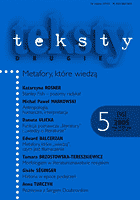Morfologizm w literaturoznawstwie rosyjskim 1920-1939
Morphologism in Russian literary scholarship of 1920s-1930s
Author(s): Tamara Brzostowska-TereszkiewiczSubject(s): Literary Texts
Published by: Instytut Badań Literackich Polskiej Akademii Nauk
Keywords: Russian literary studies; morphologism
Summary/Abstract: This article attempts at reconstructing the assumptions and systematising the varieties of the Russian morphologism of the early 20th century, understood as a biologistic orientation of literary-theoretic discourse focused on issues of internal construction of literary forms. The basis for the systematisation proposed is the history of development of theoretic biology, used by literary morphologists as a methodological model and the source notional domain of scientific metaphors. According to what has been identified along this line, Russian morphologism bifurcates into: the Cuvier mechanicism in its three varieties, i.e.: a) anatomic-taxonomic, b) functionalistic-physiological, and, c) functionalistic-organismalistic; and, anti-mechanicism, further divided into: a) transformative (non-descendential) Goetheian morphologism (in its typological and embryophysiological varieties) and b) evolutionistic morphologism. The latter occurred in three varieties: a) Lamarckian paleoembryological morphologism; b) literary-theoretic evolutionary morphology endorsed by Severcov; and, paleontology of folklore, based on the Darwinian theory of adaptation. Identification of representative implementations of the consecutive varieties of morphologism and the unveiling of its native, positivistic roots, enable one to revise the view having it that Russian formalism appeared secondary to German humanities of the late 19th/early 20th centuries, as well as to broaden the scope in which the Russian morphological formation appeared, which by this far tended to be reduced to early activities of the so-called Russian Formal School. Both Russian morphologism, in its diametrically diversified varieties, and its two sister currents: Polish morphological literary studies of 1918-1939 and the German morphological school of 1940s to 1950s, prove that the split of natural sciences and humanities, heralded in the age of the anti-positivist breakthrough, was not definite or conclusive.
Journal: Teksty Drugie
- Issue Year: 2005
- Issue No: 5
- Page Range: 53-82
- Page Count: 30
- Language: Polish

